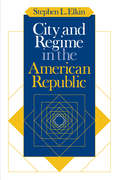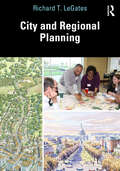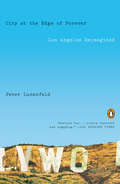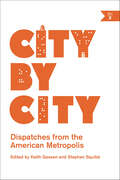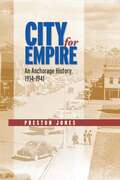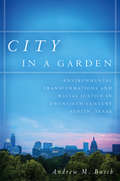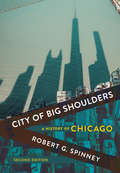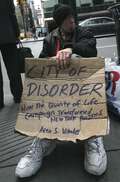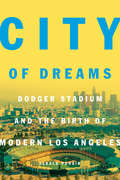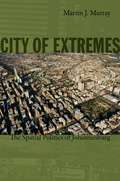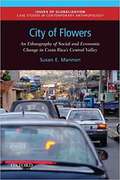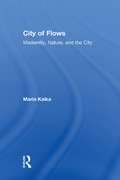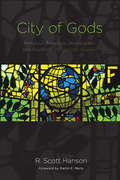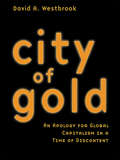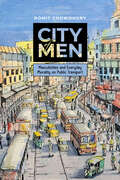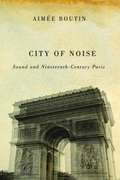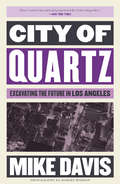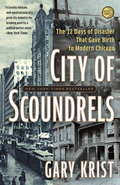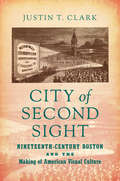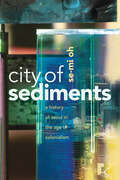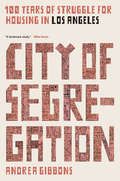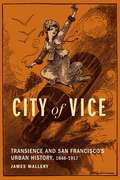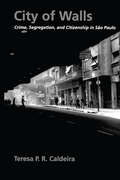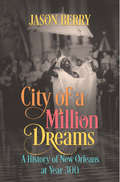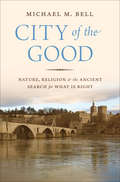- Table View
- List View
City and Regime in the American Republic
by Stephen L. ElkinStephen L. Elkin deftly combines the empirical and normative strands of political science to make a powerfully original statement about what cities are, can, and should be. Rejecting the idea that two goals of city politics—equality and efficiency—are opposed to one another, Elkin argues that a commercial republic could achieve both. He then takes the unusual step of addressing how the political institutions of the city can help to form the kind of citizenry such a republic needs. The present workings of American urban political institutions are, Elkin maintains, characterized by a close relationship between politicians and businessmen, a relationship that promotes neither political equality nor effective social problem-solving. Elkin pays particular attention to the issue of land-use in his analysis of these failures of popular control in traditional city politics. Urban political institutions, however, are not just instruments for the dispensing of valued outcomes or devices for social problem-solving—they help to form the citizenry. Our present institutions largely define citizens as interest group adversaries and do little to encourage them to focus on the commercial public interest of the city. Elkin concludes by proposing new institutional arrangements that would be better able to harness the self-interested behavior of individuals for the common good of a commercial republic.
City and Regional Planning
by Richard T. LeGatesCity and Regional Planning provides a clearly written and lavishly illustrated overview of the theory and practice of city and regional planning. With material on globalization and the world city system, and with examples from a number of countries, the book has been written to meet the needs of readers worldwide who seek an overview of city and regional planning. Chapters cover the history of cities and city and regional planning, urban design and placemaking, comprehensive plans, planning politics and plan implementation, planning visions, and environmental, transportation, and housing planning. The book pays special attention to diversity, social justice, and collaborative planning. Topics include current practice in resilience, transit-oriented development, complexity in planning, spatial equity, globalization, and advances in planning methods. It is aimed at U.S. graduate and undergraduate city and regional planning, geography, urban design, urban studies, civil engineering, and other students and practitioners. It includes extensive material on current practice in planning for climate change. Each chapter includes a case study, a biography of an important planner, lists of concepts and important people, and a list of books, articles, videos, and other suggestions for further learning.
City at the Edge of Forever: Los Angeles Reimagined
by Peter LunenfeldAn engaging account of the uniquely creative spirit and bustling cultural ecology of contemporary Los AngelesHow did Los Angeles start the 20th century as a dusty frontier town and end up a century later as one of the globe's supercities - with unparalleled cultural, economic, and technological reach? In City at the Edge of Forever, Peter Lunenfeld constructs an urban portrait, layer by layer, from serendipitous affinities, historical anomalies, and uncanny correspondences. In its pages, modernist architecture and lifestyle capitalism come together via a surfer girl named Gidget; Joan Didion's yellow Corvette is the brainchild of a car-crazy Japanese-American kid interned at Manzanar; and the music of the Manson Family segues into the birth of sci-fi fandom.One of the book's innovations is to brand Los Angeles as the alchemical city. Earth became real estate when the Yankees took control in the nineteenth century. Fire fueled the city's early explosive growth as the Southland's oil fields supplied the inexhaustible demands of drivers and their cars. Air defined the area from WWII to the end of the Cold War, with aeronautics and aerospace dominating the region's industries. Water is now the key element, and Southern California's ports are the largest in the western hemisphere. What alchemists identify as the ethereal fifth element, or quintessence, this book positions as the glamour of Hollywood, a spell that sustains the city but also needs to be broken in order to understand Los Angeles now.Lunenfeld weaves together the city's art, architecture, and design, juxtaposes its entertainment and literary histories, and moves from restaurant kitchens to recording studios to ultra-secret research and development labs. In the process, he reimagines Los Angeles as simultaneously an exemplar and cautionary tale for the 21st century.
City by City: Dispatches from the American Metropolis
by Edited by Keith Gessen and Stephen SquibbA collection of essays—historical and personal—about the present and future of American citiesEdited by Keith Gessen and Stephen Squibb, City by City is a collection of essays—historical, personal, and somewhere in between—about the present and future of American cities. It sweeps from Gold Rush, Alaska, to Miami, Florida, encompassing cities large and small, growing and failing. These essays look closely at the forces—gentrification, underemployment, politics, culture, and crime—that shape urban life. They also tell the stories of citizens whose fortunes have risen or fallen with those of the cities they call home. A cross between Hunter S. Thompson, Studs Terkel, and the Great Depression–era WPA guides to each state in the Union, City by City carries this project of American storytelling up to the days of our own Great Recession.
City for Empire: An Anchorage History, 1919-1941
by Preston JonesThe story of the early years of Alaska&’s largest city, its surprisingly diverse people, and its role in twentieth-century American history. First settled in 1915, Anchorage, in what was then known as the Territory of Alaska, was founded with the American empire in mind. During World War I, it served as a conduit through which coal could be shipped to the Pacific, where the US Navy was engaged with Japan. Years later, during World War II, Anchorage became an equally important site for the defense of the mainland and the projection of American power. City for Empire tells the story of Anchorage&’s development in that period, focusing in particular on the international context of the city&’s early decades and its surprisingly diverse inhabitants. A thorough yet accessible read, City for Empire captures the history of this remarkable city.</
City in a Garden: Environmental Transformations and Racial Justice in Twentieth-Century Austin, Texas
by Andrew M. BuschThe natural beauty of Austin, Texas, has always been central to the city's identity. From the beginning, city leaders, residents, planners, and employers consistently imagined Austin as a natural place, highlighting the region's environmental attributes as they marketed the city and planned for its growth. Yet, as Austin modernized and attracted an educated and skilled labor force, the demand to preserve its natural spaces was used to justify economic and racial segregation. This effort to create and maintain a "city in a garden" perpetuated uneven social and economic power relationships throughout the twentieth century.In telling Austin's story, Andrew M. Busch invites readers to consider the wider implications of environmentally friendly urban development. While Austin's mainstream environmental record is impressive, its minority groups continue to live on the economic, social, and geographic margins of the city. By demonstrating how the city's midcentury modernization and progressive movement sustained racial oppression, restriction, and uneven development in the decades that followed, Busch reveals the darker ramifications of Austin's green growth.
City of Big Shoulders: A History of Chicago
by Robert G. SpinneyCity of Big Shoulders links key events in Chicago's development, from its marshy origins in the 1600s to today's robust metropolis. Robert G. Spinney presents Chicago in terms of the people whose lives made the city—from the tycoons and the politicians to the hundreds of thousands of immigrants from all over the world.In this revised and updated second edition that brings Chicago's story into the twenty-first century, Spinney sweeps his historian's gaze across the colorful and dramatic panorama of the city's explosive past. How did the pungent swamplands that the Native Americans called "the wild-garlic place" burgeon into one of the world's largest and most sophisticated cities? What is the real story behind the Great Chicago Fire? What aspects of American industry exploded with the bomb in Haymarket Square? Could the gritty blue-collar hometown of Al Capone become a visionary global city?A city of immigrants and entrepreneurs, Chicago is quintessentially American. Spinney brings it to life and highlights the key people, moments, and special places—from Fort Dearborn to Cabrini-Green, Marquette to Mayor Daley, the Union Stock Yards to the Chicago Bulls—that make this incredible city one of the best places in the world.
City of Disorder: How the Quality of Life Campaign Transformed New York Politics
by Alex S. Vitale2009 Association of American University Presses Award for Jacket DesignIn the 1990s, improving the quality of life became a primary focus and a popular catchphrase of the governments of New York and many other American cities. Faced with high levels of homelessness and other disorders associated with a growing disenfranchised population, then mayor Rudolph Giuliani led New York's zero tolerance campaign against what was perceived to be an increase in disorder that directly threatened social and economic stability. In a traditionally liberal city, the focus had shifted dramatically from improving the lives of the needy to protecting the welfare of the middle and upper classes—a decidedly neoconservative move.In City of Disorder, Alex S. Vitale analyzes this drive to restore moral order which resulted in an overhaul of the way New York views such social problems as prostitution, graffiti, homelessness, and panhandling. Through several fascinating case studies of New York neighborhoods and an in-depth look at the dynamics of the NYPD and of the city's administration itself, Vitale explains why Republicans have won the last four New York mayoral elections and what the long-term impact Giuliani's zero tolerance method has been on a city historically known for its liberalism.
City of Dreams: Dodger Stadium and the Birth of Modern Los Angeles
by Jerald PodairOn the sixtieth anniversary of the Dodgers' move to Los Angeles, the full story of the controversial building of Dodger Stadium and how it helped transform the city.When Walter O'Malley moved his Brooklyn Dodgers to Los Angeles in 1957 with plans to construct a new ballpark next to downtown, he ignited a bitter argument over the future of a rapidly changing city. For the first time, City of Dreams tells the full story of the controversial building of Dodger Stadium—and how it helped create modern Los Angeles by transforming its downtown into a vibrant cultural and entertainment center.In a vivid narrative, Jerald Podair tells how Los Angeles was convulsed between 1957 and 1962 over whether, where, and how to build Dodger Stadium. Competing civic visions clashed. Would Los Angeles be a decentralized, low-tax city of neighborhoods, as demanded by middle-class whites on its peripheries? Or would the baseball park be the first contribution to a revitalized downtown that would brand Los Angeles as a national and global city, as advocated by leaders in business, media, and entertainment?O'Malley's vision triumphed when he opened his privately constructed stadium on April 10, 1962—and over the past half century it has contributed substantially to the city's civic and financial well-being. But in order to build the stadium, O'Malley negotiated with the city to acquire publicly owned land (from which the city had uprooted a Mexican American community), raising sharply contested questions about the relationship between private profit and "public purpose." Indeed, the battle over Dodger Stadium crystallized issues with profound implications for all American cities, and for arguments over the meaning of equality itself.Filled with colorful stories, City of Dreams will fascinate anyone who is interested in the history of the Dodgers, baseball, Los Angeles, and the modern American city.
City of Extremes: The Spatial Politics of Johannesburg
by Martin J. MurrayCity of Extremes is a powerful critique of urban development in greater Johannesburg since the end of apartheid in 1994. Martin J. Murray describes how a loose alliance of city builders--including real estate developers, large-scale property owners, municipal officials, and security specialists--has sought to remake Johannesburg in the upbeat image of a world-class city. By creating new sites of sequestered luxury catering to the comfort, safety, and security of affluent urban residents, they have produced a new spatial dynamic of social exclusion, effectively barricading the mostly black urban poor from full participation in the mainstream of urban life. This partitioning of the cityscape is enabled by an urban planning environment of limited regulation or intervention into the prerogatives of real estate capital. Combining insights from urban studies, cultural geography, and urban sociology with extensive research in South Africa, Murray reflects on the implications of Johannesburg's dual character as a city of fortified enclaves that proudly displays the ostentatious symbols of global integration and the celebrated "enterprise culture" of neoliberal design, and as the "miasmal city" composed of residual, peripheral, and stigmatized zones characterized by signs of a new kind of marginality. He suggests that the "global cities" paradigm is inadequate to understanding the historical specificity of cities in the Global South, including the colonial mining town turned postcolonial megacity of Johannesburg.
City of Flowers: An Ethnography of Social and Economic Change in Costa Rica's Central Valley (Issues Of Globalization: Case Studies in Contemporary Anthropology)
by Susan E. MannonCity of Flowers is an ethnographic study of social and economic change in Costa Rica. Rather than investigate how macroeconomic forces bear down on workers and households, this book explores how individuals and households give meaning and shape to neoliberalism as it evolves over time. Drawing on twenty years of field work and 100 life histories of people living in one Costa Rican city, the book considers how individuals in four different class locations negotiate the economic changes going on around them. Author Susan E. Mannon argues that these responses are bound up in class, race, and gender aspirations and anxieties.
City of Flows: Modernity, Nature, and the City
by Maria KaikaTypically, cities and nature are perceived as geographic opposites, cities being manufactured social creations, and nature being outside of human construction. Through a historical geography of water in the modern city, Kaika shows that this is not the case. Rather, nature and the modern city are fully intertwined, with cities integrating nature at
City of Gods: Religious Freedom, Immigration, and Pluralism in Flushing, Queens
by R. Scott HansonReligious Freedon, Immigration, and Pluralism in Flushing, Queens
City of Gold: An Apology for Global Capitalism in a Time of Discontent
by David A. WestbrookDavid A. Westbrook argues that we live in "the city of gold"--a global, cosmopolitan polity where politics are done through markets, and where global capital markets, not states, have become the dominant force in our social life.
City of Men: Masculinities and Everyday Morality on Public Transport
by Romit ChowdhuryIn South Asian urban landscapes, men are everywhere. And yet we do not seem to know very much about precisely what men do in the city as men. How do men experience gender in city spaces? What are the interactional dynamics between different groups of men on city streets? How do men adjudicate between good and bad conduct in urban spaces? Through ethnographic descriptions of copresence on public transport in Kolkata, India, this book brings into sight the gendered logics of cooperation and everyday morality through which masculinities take up space in cities. It follows the labor geographies of auto-rickshaw and taxi operators and their interactions with traffic police and commuters to argue that the gendered fabric of urban life needs to be understood as a product of situational forms of cooperation between different social groups. Such an orientation sheds light on the part played by everyday morality and provisional support in upholding male privilege in the city.
City of Noise: Sound and Nineteenth-Century Paris
by Aimee BoutinBeloved as the city of light, Paris in the nineteenth century sparked the acclaim of poets and the odium of the bourgeois with its distinctive sounds. Street vendors bellowed songs known as the Cris de Paris that had been associated with their trades since the Middle Ages; musicians itinerant and otherwise played for change; and flâneurs-writers, fascinated with the city's underside, listened and recorded much about what they heard. Aimée Boutin tours the sonic space that orchestrated the different, often conflicting sound cultures that defined the street ambience of Paris. Mining accounts that range from guidebooks to verse, Boutin braids literary, cultural, and social history to reconstruct a lost auditory environment. Throughout, impressions of street noise shape writers' sense of place and perception of modern social relations. As Boutin shows, the din of the Cris contrasted economic abundance with the disparities of the capital, old and new traditions, and the vibrancy of street commerce with an increasing bourgeois demand for quiet. In time, peddlers who provided the soundtrack for Paris's narrow streets yielded to modernity, with its taciturn shopkeepers and wide-open boulevards, and the fading songs of the Cris became a dirge for the passing of old ways.
City of Quartz: Excavating the Future in Los Angeles
by Mike Davis Robert MorrowNo metropolis has been more loved or more hated. To its official boosters, "Los Angeles brings it all together." To detractors, LA is a sunlit mortuary where "you can rot without feeling it." To Mike Davis, the author of this fiercely elegant and wide- ranging work of social history, Los Angeles is both utopia and dystopia, a place where the last Joshua trees are being plowed under to make room for model communities in the desert, where the rich have hired their own police to fend off street gangs, as well as armed Beirut militias. In City of Quartz, Davis reconstructs LA's shadow history and dissects its ethereal economy. He tells us who has the power and how they hold on to it. He gives us a city of Dickensian extremes, Pynchonesque conspiracies, and a desperation straight out of Nathaniel Westa city in which we may glimpse our own future mirrored with terrifying clarity.In this new edition, Davis provides a dazzling update on the city's current status.
City of Scoundrels: The 12 Days of Disaster That Gave Birth to Modern Chicago
by Gary KristThe masterfully told story of twelve volatile days in the life of Chicago, when an aviation disaster, a race riot, a crippling transit strike, and a sensational child murder transfixed and roiled a city already on the brink of collapse.When 1919 began, the city of Chicago seemed on the verge of transformation. Modernizers had an audacious, expensive plan to turn the city from a brawling, unglamorous place into "the Metropolis of the World." But just as the dream seemed within reach, pandemonium broke loose and the city's highest ambitions were suddenly under attack by the same unbridled energies that had given birth to them in the first place.It began on a balmy Monday afternoon when a blimp in flames crashed through the roof of a busy downtown bank, incinerating those inside. Within days, a racial incident at a hot, crowded South Side beach spiraled into one of the worst urban riots in American history, followed by a transit strike that paralyzed the city. Then, when it seemed as if things could get no worse, police searching for a six-year-old girl discovered her body in a dark North Side basement.Meticulously researched and expertly paced, City of Scoundrels captures the tumultuous birth of the modern American city, with all of its light and dark aspects in vivid relief.
City of Second Sight: Nineteenth-Century Boston and the Making of American Visual Culture
by Justin T. ClarkIn the decades before the U.S. Civil War, the city of Boston evolved from a dilapidated, haphazardly planned, and architecturally stagnant provincial town into a booming and visually impressive metropolis. In an effort to remake Boston into the "Athens of America," neighborhoods were leveled, streets straightened, and an ambitious set of architectural ordinances enacted. However, even as residents reveled in a vibrant new landscape of landmark buildings, art galleries, parks, and bustling streets, the social and sensory upheaval of city life also gave rise to a widespread fascination with the unseen. Focusing his analysis between 1820 and 1860, Justin T. Clark traces how the effort to impose moral and social order on the city also inspired many—from Transcendentalists to clairvoyants and amateur artists—to seek out more ethereal visions of the infinite and ideal beyond the gilded paintings and glimmering storefronts.By elucidating the reciprocal influence of two of the most important developments in nineteenth-century American culture—the spectacular city and visionary culture—Clark demonstrates how the nineteenth-century city is not only the birthplace of modern spectacle but also a battleground for the freedom and autonomy of the spectator.
City of Sediments: A History of Seoul in the Age of Colonialism
by Se-Mi OhOnce the capital of the five-hundred-year Chosŏn dynasty (1392–1897) and the Taehan Empire (1897–1910), the city of Seoul posed unique challenges to urban reform and modernization under Japanese colonial rule in the early twentieth century, constrained by the labyrinthian built environment of the old Korean capital. Colonial authorities attempted to employ a strategy of "erasure"—monumental Japanese architecture was, for instance, superimposed upon existing palace structures—to articulate to colonized Korean subjects the transition from the pre-modern to the modern, and the naturalization of colonial rule as inevitable historical change. Drawing from and analyzing a wide range of materials, from architecture and photography to print media and sound recordings, City of Sediments shows how Seoul became a site to articulate a new mode of time—modernity—that defined the place of the colonized in accordance with the progression of history, and how the underbelly of the city, latent places of darkness filled with chatters of the alleyway, challenged this visual language of power. To do so, Se-Mi Oh builds an inventive new model of history where discrete events do not unfold one after the other, but rather one in which histories layer atop each other like sediment, allowing a new map of colonial Seoul to emerge, a map where the material traces of the city are overlapping, with vibrant residues of earlier times defiantly visible among the superimposed signs of modernity and colonial domination.
City of Segregation: 100 Years of Struggle for Housing in Los Angeles
by Andrea GibbonsA majestic one-hundred-year study of segregation in Los AngelesCity of Segregation documents one hundred years of struggle against the enforced separation of racial groups through property markets, constructions of community, and the growth of neoliberalism. This movement history covers the decades of work to end legal support for segregation in 1948; the 1960s Civil Rights movement and CORE’s efforts to integrate LA’s white suburbs; and the 2006 victory preserving 10,000 downtown residential hotel units from gentrification enfolded within ongoing resistance to the criminalization and displacement of the homeless. Andrea Gibbons reveals the shape and nature of the racist ideology that must be fought, in Los Angeles and across the United States, if we hope to found just cities.
City of Vice: Transience and San Francisco's Urban History, 1848–1917
by James MallerySan Francisco&’s reputation for accommodating progressive and unconventional identities can find its roots in the waves of transients and migrants that flocked to San Francisco between the gold rush and World War I. In the era of yellow journalism, San Francisco&’s popular presses broadcast shocking stories about the waterfront, Chinatown, Barbary Coast, hobo Main Stem, Uptown Tenderloin, and Outside Lands. The women and men who lived in these districts did not passively internalize the shaming of their bodies or neighborhoods. Rather, many urbanites intentionally sought out San Francisco&’s &“vice&” and transient lodging districts. They came to identify themselves in ways opposed to hegemonic notions of whiteness, respectability, and middle-class heterosexual domesticity. With the destabilizing 1906 earthquake marking its halfway point, James Mallery&’s City of Vice explores the imagined, cognitive mapping of the cityscape and the social history of the women and men who occupied its so-called transient and vice districts between the late nineteenth century and World War I.
City of Walls: Crime, Segregation, and Citizenship in São Paulo
by Teresa P. CaldeiraTeresa Caldeira's pioneering study of fear, crime, and segregation in São Paulo poses essential questions about citizenship and urban change in contemporary democratic societies. Focusing on São Paulo, and using comparative data on Los Angeles, she identifies new patterns of segregation developing in these cities and suggests that these patterns are appearing in many metropolises.
City of a Million Dreams: A History of New Orleans at Year 300
by Jason BerryIn 2015, the beautiful jazz funeral in New Orleans for composer Allen Toussaint coincided with a debate over removing four Confederate monuments. Mayor Mitch Landrieu led the ceremony, attended by living legends of jazz, music aficionados, politicians, and everyday people. The scene captured the history and culture of the city in microcosm--a city legendary for its noisy, complicated, tradition-rich splendor. In City of a Million Dreams, Jason Berry delivers a character-driven history of New Orleans at its tricentennial. Chronicling cycles of invention, struggle, death, and rebirth, Berry reveals the city's survival as a triumph of diversity, its map-of-the-world neighborhoods marked by resilience despite hurricanes, epidemics, fires, and floods.Berry orchestrates a parade of vibrant personalities, from the founder Bienville, a warrior emblazoned with snake tattoos; to Governor William C. C. Claiborne, General Andrew Jackson, and Pere Antoine, an influential priest and secret agent of the Inquisition; Sister Gertrude Morgan, a street evangelist and visionary artist of the 1960s; and Michael White, the famous clarinetist who remade his life after losing everything in Hurricane Katrina. The textured profiles of this extraordinary cast furnish a dramatic narrative of the beloved city, famous the world over for mysterious rituals as people dance when they bury their dead.
City of the Good: Nature, Religion, and the Ancient Search for What Is Right
by Michael Mayerfield BellHow we came to seek absolute good in religion and nature—and why that quest often leads us astrayPeople have long looked to nature and the divine as paths to the good. In this panoramic meditation on the harmonious life, Michael Mayerfeld Bell traces how these two paths came to be seen as separate from human ways, and how many of today’s conflicts can be traced back thousands of years to this ancient divide.Taking readers on a spellbinding journey through history and across the globe, Bell begins with the pagan view, which sees nature and the divine as entangled with the human—and not necessarily good. But the emergence of urban societies gave rise to new moral concerns about the political character of human life. Wealth and inequality grew, and urban people sought to justify their passions. In the face of such concerns, nature and the divine came to be partitioned from the human, and therefore seen to be good—but they also became absolute and divisive.Bell charts the unfolding of this new moral imagination in the rise of Buddhism, Christianity, Daoism, Hinduism, Jainism, and many other traditions that emerged with bourgeois life. He follows developments in moral thought, from the religions of the ancient Sumerians, Greeks, and Hebrews to the science and environmentalism of today, along the way visiting with contemporary indigenous people in South Africa, Costa Rica, and the United States. City of the Good urges us to embrace the plurality of our traditions—from the pagan to the bourgeois—and to guard against absolutism and remain open to difference and its endless creativity.
